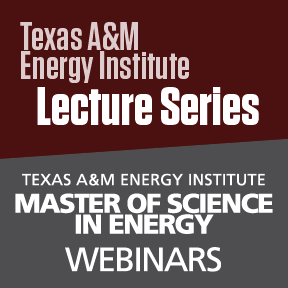
Deployment of Nanowire-based Energy Conversion Devices and Composites: Opportunities and Barriers
The next presentation in the Texas A&M Energy Institute Lecture Series: Master of Science in Energy Webinars, featuring Dr. Sreeram Vaddiraju, an Associate Professor in the Artie McFerrin Department of Chemical Engineering at Texas A&M University, will be held on Wednesday, October 28, 2020, from 11:00 a.m. – 12:00 p.m. CDT (GMT -5:00) through an online Zoom meeting. The topic will be “Deployment of Nanowire-based Energy Conversion Devices and Composites: Opportunities and Barriers.”
Abstract
The idea that materials with dimensions much smaller than 100 nm (i.e., nanomaterials) may exhibit properties that are not observed in their bulk counterparts has led researchers to document the properties of a wide variety of nanomaterials over the last three decades. For instance, nanowires have been demonstrated to function not only as efficient solar cells and thermoelectrics, but also as photocatalysts for either producing hydrogen fuel from water or disinfecting water. They have also been demonstrated to be useful as fillers in tailoring the properties of composites. At the current time, most of these lab-scale demonstrations have primarily been made using individual nanowires and/or small-scale nanowire arrays and mats. Translating these demonstrations into industrial-scale production and deployment of nanowire-based devices requires extending enhanced energy conversion performances demonstrated in single nanowires and/or small-scale nanowire arrays and mats to devices composed of large-scale nanowire assemblies. This, in turn, requires the confluence of many desired nanowire properties ranging from thermal, electrical, and electronic properties to mechanical properties. For example, packing nanowires into highly-dense nanowire assemblies for fabricating thermoelectrics devices requires that the nanowires be mechanically flexible to prevent their breakage during assembly. Contextually, this talk addresses many aspects involved in accomplishing such a task. It begins with a discussion of techniques specifically developed for the mass production and interface-engineered assembly of Zn3P2, ZnO, Si, and Mg2Si nanowires. The impact of these strategies on the heat-to-electricity conversion efficiencies of nanowire-based bulk thermoelectrics will be presented in detail. The impact of these strategies on the functioning of nanowires as fillers in shape memory polymer composites will also be discussed. Finally, opportunities and barriers associated with the deployment of nanowire-based energy conversion devices will be explained.
Biography
Dr. Sreeram Vaddiraju is currently an Associate Professor in the Department of Chemical Engineering at Texas A&M University. He started working at the university in the fall of 2009. Before this, he received his academic training at various academic institutions and national labs, including the University of Louisville, NASA Ames Research Center, and Massachusetts Institute of Technology. Currently, a bulk of his research is focused on the development of inexpensive and efficient nanowire-based renewable energy devices and systems (e.g., thermoelectrics, photovoltaics, photocatalysts for solar hydrogen production and water disinfection). More specifically, he has been working on both the mass production and the interface-engineered assembly of nanowires toward realizing translation of the novel properties expected of individual nanowires to bulk nanowire assemblies. This overall vision of his research effort is to streamline the production of nanowire-based energy conversion devices in a manner similar to that achieved with drug production by the pharmaceutical industry and integrated chip (IC) production by the electronics industry.
